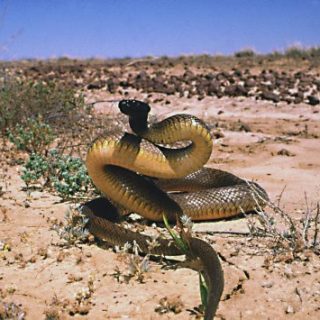

Most deaths caused by snake bites in Papua New Guinea are caused by this snake. The Papuan taipan is a relative of the coastal taipan. Compared to the inland taipan, the coastal taipan is a lot more aggressive and lives near people to prey on rats and other small animals. They give you only a moment to back off before striking, and this snake is extremely fast and accurate when biting. It looks like a tight S shape with their head facing fiercely in the direction of their enemy. It has a defensive position that it gets into when it feels threatened. Before an antidote was developed, its bite was 100% deadly. In fact, the Inland Taipan is a relatively shy species of snake. One bite can kill up to 12,000 guinea pigs.

It is also the third most venomous snake in the world. Inland taipan can survive over 20 years in the captivity.At up to 0.5 inch (13 mm), the coastal taipan has the longest fangs of all Australian venomous snakes and is also the longest venomous snake in Australia. Females produce two broods per year when food is plentiful.įemale lays 12 to 24 egg in the crevices of rocks or inside the abandoned burrows of various animals. Mating season of inland taipans takes place from July to December. The species of fierce snake is known to live around wetlands and semi-arid areas in the islands of Southeastern Australia. Natural enemies of inland taipans are king brown snakes and large monitor lizards.


Humans die 30 to 45 minutes after attack in the case that antivenin is not available. Humans rarely encounter inland taipans in the wild and bites are extremely rare (inland taipans bite only in self-defense). Inland taipan is also known as "fierce snake" because of its potent venom (it is not aggressive by nature). Each bite delivers amount of venom that can kill 100 adult men or 250.000 mice. Inland taipan is classified as the most venomous snake on the planet. Its diet consists of rodents, small mammals and birds. Inland taipan has excellent eyesight and sense of smell which are used for detection of the prey. Abundance of food (rodents) facilitates reproduction and leads to rapid increase in the number of inland taipans. Inland taipan is terrestrial animal (adapted to the life on the ground). Number of inland taipans in the wild depends on the number of rodents.
INLAND TAIPAN FACTS CRACK
It retreats and waits inside the crack in the soil until victim dies before it returns to swallow it. Habitat: Taipans primarily occur in open habitats such as deserts, floodplains and grasslands, but coastal taipans are also found in savannah woodland, dry. Inland taipan is an agile snake that is able to bite 8 times in a single attack. Its diet consists of rodents, small mammals and birds. When it comes to Inland taipan vs black mamba, the inland taipan is definitely more dangerous. Inland taipan is terrestrial animal (adapted to the life on the ground). Its the most venomous snake in the world, but not the most deadly This reclusive snake can deliver a punch of poison powerful enough to kill 100 men and a. It becomes active during the night (nocturnal) during extremely hot periods of the year. Inland taipan is usually active early in the morning (diurnal).
INLAND TAIPAN FACTS SKIN
Light-colored body prevents overheating of inland taipan during the summer, while dark-colored skin ensures accumulation of the heat during the winter. Rounded snout, head and neck are darker than the rest of the body.Ĭolor of the body depends on the season. Scales on dorsal and lateral sides of the body have black edges which create V-shaped markings along the body. Inland taipan has light brown or brownish to light green back. Inland taipan can reach 6 to 8 feet in length. According to the Australian official sources, inland taipans are rare in the Queensland and numerous in the South Australia. Inland taipan is endemic for Australia (it can be found only there and nowhere else). During cooler winter months, their skin turns from a light greenish-yellow a dark brownish-black. Inland taipan was discovered at the end of the 19 th century, but scientists couldn't describe and examine this species until the appearance of the next specimen 90 years later. 6 to 8 feet Cool Facts: Unlike other snakes, the taipan is capable of changing color. It can be found in semi-arid areas of Central and East Australia. Inland taipan is venomous snake that belongs to the group of elapid snakes.


 0 kommentar(er)
0 kommentar(er)
